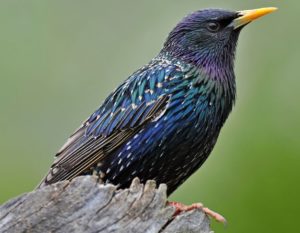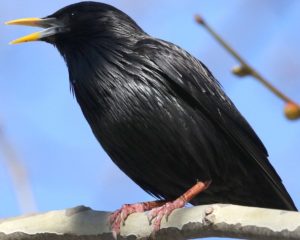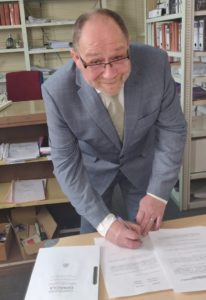Starlings – the master impersonators in your garden


Only tangentially about language matters this time but rather an excuse to talk about another of my loves – ornithology.
Starlings are among the most frequently seen and recognisable of garden birds across Europe. In Spain, the spotless starling (Sturnus unicolor, right), with its oily-looking black plumage is more common than the somewhat prettier European starling (Sturnus vulgaris, left). Nevertheless, both share the same ability to perfectly mimic the birdsong of other species – in our garden we’ve heard them imitate magpies, blackbirds and blue tits and probably many others as well.
What is perhaps less well-known is their uncanny ability to imitate human language and “whistle” the music they hear. Our ignorance as Europeans in this regard is perhaps unsurprising – as wild birds we rarely get close to them and never for long enough to “teach” them to repeat anything we might say to them. However, the situation is different in the United States, where they can be kept at home.
There is a curious reason for this. US federal law states that autochthonous birds may not be kept as pets while species originating from outside the country can (thus allowing people to keep parrots, canaries and other exotic birds). Starlings are not native to North America but were introduced by the amateur ornithologist Eugene Schieffelin, who released 60 starlings into New York City’s Central Park in 1890 as part of a rather quixotic plan to bring all the birds mentioned in the works of William Shakespeare to the continent. Their population is now estimated to be approximately 200 million.
While starlings are obviously far less common as pets than parrots in the US, people do keep them in their homes, perhaps having rescued a young bird that has fallen from the nest. You can see and hear their prodigious “language” and “musical” skills here and here.
I will leave you with another amazing skill of these underestimated birds, their complex, spectacular flocking abilities, resulting in seemingly orchestrated mass flight patterns that almost resemble an aerial ballet. This magical phenomenon even has a specific name when performed by starlings, the masters of the art, which is one of my favourite words in English – a murmuration. The Spanish “cousin” of this word, murmuración, refers not to starlings in flight but rather to “a conversation that is detrimental to someone who is not present” according to the dictionary of the Real Academia Española – gossip in other words, the subject of my next post.
Estorninos – los imitadores magistrales en tu jardín


Esta entrada sólo tiene una relación tangencial con los asuntos lingüísticos pero me da una oportunidad de hablar de otra de mis pasiones – el mundo de las aves.
Los estorninos figuran entre las aves de jardín más comunes y reconocibles en toda Europa. En España, el estornino negro (Sturnus unicolor, a la derecha), con su plumaje negro y oleoso, se ve con más frecuencia que el más colorido estornino europeo o pinto (Sturnus vulgaris, a la izquierda). No obstante, las dos especies comparten la misma habilidad de imitar a la perfección el canto de otros pájaros – en nuestro jardín les oímos asemejarse a las urracas, a los mirlos y a los herrerillos, entre otras especies.
Quizás menos sabido es su asombrosa capacidad de imitar la voz humana y “silbar” la música que escuchan. Nuestra ignorancia como europeos a este respecto no debería sorprendernos – como aves salvajes es raro que nos dejen acercarnos mucho, y nunca durante el tiempo suficiente para “enseñarles” a repetir lo que les decimos. Sin embargo, este no es el caso en los Estados Unidos, donde se permite tenerlos como aves de compañía.
El porqué de esta situación resulta curioso. La ley federal en aquel país prohíbe la domesticación de los pájaros autóctonos; no obstante, se permite en el caso de las especies “forasteras” (posibilitando así que la gente pueda tener loros, canarios y otras aves exóticas como mascotas). Los estorninos no son autóctonos de América de Norte, sino que fueron introducidos por Eugene Schieffelin, un aficionado a la ornitología que soltó 60 estorninos en Central Park de Nueva York en 1890 como parte de su proyecto algo quijotesco de traer todas las aves mencionadas en las obras de William Shakespeare al continente. La población actual de estorninos en el país se estima en 200 millones de ejemplares, aproximadamente.
Obviamente, los estorninos son mucho menos frecuentes en las casas estadounidenses que los loros; no obstante hay personas que los tienen como aves de compañía, a lo mejor después de rescatar un pájaro joven que se ha caído de su nido. Se puede ver y escuchar ejemplos de sus prodigiosas habilidades “lingüísticas” y “musicales” aquí y aquí.
Os dejo con otro don increíble de estos pájaros subestimados, sus bandadas complejas y espectaculares – vuelos en masa formados por numerosas aves que parecen estar orquestados, como un inmenso ballet en el aire. Este fenómeno mágico tiene un nombre específico en inglés cuando es interpretado por los estorninos, los verdaderos maestros de ese arte (ver el vídeo arriba). Resulta ser una de mis favoritas en la lengua inglesa – una murmuration. Evidentemente, murmuración, la “prima hermana” de esta palabra en español, no hace referencia a los vuelos de los estorninos sino a una conversación en perjuicio de un ausente según el RAE – es decir, el cotilleo, el tema del post siguiente.


